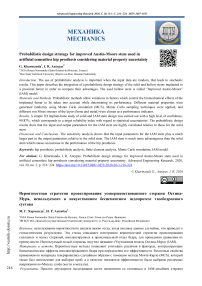Probabilistic design strategy for improved Austin-Moore stem used in artificial cementless hip prosthesis considering material property uncertainty
Автор: Kharmanda G., Antypas I.R.
Журнал: Advanced Engineering Research (Rostov-on-Don) @vestnik-donstu
Рубрика: Механика
Статья в выпуске: 3 т.20, 2020 года.
Бесплатный доступ
Introduction. The use of probabilistic analysis is important when the input data are random, that leads to stochastic results. This paper describes the integration of a probabilistic design strategy of the solid and hollow stems implanted in a proximal femur in order to compare their advantages. The used hollow stem is called “Improved Austin-Moore” (IAM) model. Materials and Methods. Probabilistic methods allow variations in factors which control the biomechanical effects of the implanted femur to be taken into account while determining its performance. Different material properties were generated randomly using Monte Carlo simulation (MCS). Monte Carlo sampling techniques were applied, and different von Mises stresses of the layers (bone and metal) were chosen as a performance indicator. Results. A simple 2D implant-bone study of solid and IAM stem design was carried out with a high level of confidence, 99.87%, which corresponds to a target reliability index with regard to statistical uncertainties. The probabilistic design results show that the input and output parameters for the IAM stem are highly correlated relative to those for the solid stem. Discussion and Conclusions. The sensitivity analysis shows that the input parameters for the IAM stem play a much larger part in the output parameters relative to the solid stem. The IAM stem is much more advantageous than the solid stem which causes an increase in the performance of the hip prosthesis.
Модель iam, hip prosthesis, probabilistic analysis, finite element analysis, monte carlo simulation, iam model
Короткий адрес: https://sciup.org/142225496
IDR: 142225496 | DOI: 10.23947/2687-1653-2020-20-3-216-224
Список литературы Probabilistic design strategy for improved Austin-Moore stem used in artificial cementless hip prosthesis considering material property uncertainty
- Gonzalez CD. Probabilistic Finite Element Analysis of Un-cemented Total Hip Replacement, PhD thesis. School of Engineering Sciences, Bioengineering Sciences Research Group: University of Southampton; March 2009.
- Kharmanda G, Antypas I. Reliability-based design algorithm for artificially replaced hip prosthesis considering material property uncertainty. Journal of Advances in Engineering Research, AER. 2018. Advances in Engineering Research (AER). 2018;157:44-50. https://www.atlantis-press.com/proceedings/aime-18/25901891
- Kharmanda G, El-Hami A, Ibrahim MH. Integration of reliability and optimization concepts into orthopedic prosthesis design: Application on hip prosthesis design. Journal of Uncertainties and Reliability of Multiphysical Systems. 2017. DOI: 10.21494.ISTE.OP.2017.0120
- Kharmanda G, Albashi L. Numerical Study for Increasing Efficiency of Artificially Un-cemented Hip Joint. Research Journal of Aleppo University, Engineering Science Series. 2011;101:47-64.
- Kharmanda G, Mulki S, Sabsabi Y. Compter-Aided Design of Internal Replacement Models in Orthopedics Surgery. Research Journal of Aleppo University, Engineering Science Series. 2012;105:312-328.
- Kharmanda G. Integration of multi-objective structural optimization into cementless hip prosthesis design: Improved Austin-Moore model, Computer Methods. Biomechanics and Biomedical Engineering. 2016;19(14):1557- 1566.
- DOI: 10.1080/10255842.2016.1170121
- Mackerle J. Finite element modeling and simulations in orthopedics. Bibliography 1998-2005, J. Computer Methods in Biomechanics and Biomedical Engineering. 2006; 9(3):149-199.
- DOI: 10.1080/10255840600751523
- Senapati S-K, Pal S. UHMWPE-alumina Ceramic Composite. A Proposed Metal Substitute for Artificially Replaced Hip Joint. IE (I) Journal MC. 2005;85:157-162. https://www.researchgate.net/scientificcontributions/2092553592_SK_Senapati.
- Shaik SA, Bose K, Cherukuri HP. A study of durability of hip implants. Materials and Design. 2012;42:230-237.
- DOI: 10.1016/j.matdes.2012.05.049
- Beaupré GS, Orr TE, Carter DR. An approach for time-dependent bone modeling and remodelingapplication: a preliminary remodeling simulation. Journal of Orthopaedic Research. 1990;8(5):662-670.
- DOI: 10.1002/jor.1100080507
- Kharmanda G, El-Hami A. Reliability Concept. Reliability in Biomechanics. 2016:63-112. 10.1002/9781119370840.ch2 P.
- DOI: 10.1002/9781119370840.ch2P
- Haldar A, Mahadevan S. Probability, reliability and statistical methods. Engineering design. New York, USA: John Willey & Sons; 2000. P. 304. https://books.google.ru/books?id=wZNRAAAAMAAJ&redir_esc=y
- McKay MD, Beckman RJ, Conover WJ. A comparison of three methods for selecting values of input variables. The analysis of output from a computer code. Technometrics. 1979;42:55-61.
- DOI: 10.1080/00401706.1979.10489755
- Kharmanda G, Antypas I. Integration of Reliability Concept into Soil Tillage Machine Design. Vestnik of Vestnik of Don State Technical University. 2015;15(2):22-31.
- DOI: 10.12737/11610
- Jeppsson J. Reliability-based assessment procedures for existing concrete structures: PhD dissertation. Division of Structural Engineering, Lund University. 2003. P. 199.
- Cheal E, Spector M, Hayes W. Role of loads and prosthesis material properties on the mechanics of the proximal femur after total hip arthroplasty. Journal of Orthopaedic Research. 1992;10(3):405-422.
- DOI: 10.1002/jor.1100100314
- Kayabasi O, Ekici B. Probabilistic design of a newly designed cemented hip prosthesis using finite element method. Materials and Design. 2008;9(5):963-971.
- DOI: 10.1016/j.matdes.2007.03.024


